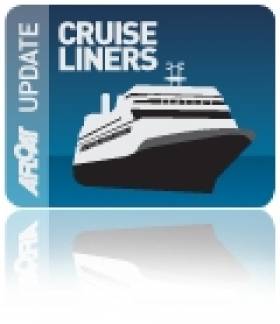Displaying items by tag: Azamara Club Cruises
All Things Nautical As Sisters to Meet On a Journey
#CRUISESHIP SISTERS – Oceania Cruises Nautica (2000/30,277grt) currently docked in Dublin Port will later today be joined by a sister, Azamara Journey, operated by Azamara Club Cruises, writes Jehan Ashmore
Azamara Journey had departed Leith and is heading through the Irish Sea and is expected to arrive in the capital port around mid-afternoon.
Both vessels (circa 680 passengers) form part of an original eight-strong sister fleet of French built 'R' class ships ordered for Renaissance Cruises, which ceased trading in 2001, resulting in the splitting of the ships to various owners.
Incidentally Oceania Cruises also operate two more such sisters. Regatta built as R Five and Insignia, the former R1, the lead-ship of the series all having the previous owner's rather simplistic naming theme. Likewise Azamara Club Cruises operate the former R Seven, rechristened Azamara Quest.
Another 'R' class sister operating for P&O Cruises, the Adonia, which led the seven-strong spectacular sail-past in Southampton waters for the 'Grand Event' to celebrate the 175th anniversary of the famous company, is due to call to Foynes in a fortnight's time.
Noting that Adonia, led the liner line-up which included Arcadia (as previously reported), seen third in line astern and where each ship set off on separate cruises as they headed out of the Solent.
Dublin Is Fly-Cruise Hub as 'Journey' Heads for Iberian Sun
Tonight's departure is for Holyhead, where the call to Anglesey also covers tours of Snowdonia, the impressive castles of Conwy, Caernarvon and Harlech and a stop to Bodnant. Following the Welsh call she is to visit Cobh. Other calls are to Bordeaux (overnight), Bibao, Gijon,Vigo and the final port of call is Lisbon on 7 September where passengers will remain in their cabins for an overnight stay. The next day there is a scheduled tour of the Gulbenkian Museum, the Jeronimos Monastery and Sintra.
On one-day the ship will spend the entire day at sea which will enable passengers to indulge further of the facilities such as the casino and entertainment in the theatre, for more click HERE. Fares for the Irish passengers of the 10-day cruise/11-day holiday started at €2,062 per person (cruise-only) based on the lowest grade twin cabin. After completion of the cruise in Lisbon they will take a flight to return to Dublin.
Azamara Journey formed part of the eight-strong series commissioned for Renaissance Cruises which collapsed a decade ago. They were built by Chantiers de l'Atlantique in St.Nazaire and were uninspiringly named as R One, R Two etc with the R Six now the re-named Azamara Journey.
As August and the high-season draws to a close that doesn't' stop the cruiseships calling as over twenty more are due in Dublin before the season closes. In total the port this year has handled some 90 cruiseships and 160,000 passengers. A further 65 callers so far are scheduled for 2012.
- Cobh
- Dublin Port
- Cruise Liners
- Princess Cruises
- Holyhead
- Anglesey
- Ports and Shipping
- Cobh Cruise Terminal
- Port of Dublin
- Cruise Liner news
- Trinity College
- Cruise ships
- Ocean Princess
- Azamara Club Cruises
- Azamara Journey
- Renaissance Cruises
- R6
- Powerscourt Gardens
- Gulbenkian Mseum
- Lisbon
- Western European Cruises
- Dublin cruise terminal
- Welsh cruise calls
- Welsh castles
- R Six
- Chantiers de l'Atlantique






























































